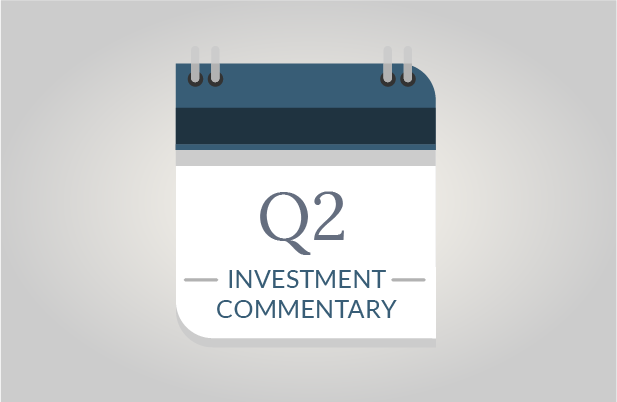- Investment returns trended higher despite a slump in April.
- Recent data on the economy and inflation raises hopes of a Fed rate cut before year-end.
- The June presidential debate added a new level of unknown as we approach the November elections.
A Strong First Half of the Year
Healthy stock returns of the first quarter experienced a temporary pullback to start the second quarter when inflation ticked higher, and Iran launched a drone attack on Israel in April. Fortunately, the market retreat only lasted a few short weeks and was followed by a full rebound and further expansion in stock performance. Investors continue to be rewarded in 2024.
Several factors contributed to market gains in May and June. These included strong corporate earnings, a cooling in the job market (which is actually a positive factor), a retrenchment in inflation, and technology stocks bolstered by AI advancements.
A summary of investment market returns as of June 30, 2024, is as follows:
Bloomberg U.S. Aggregate (U.S. bonds) -0.71%
S&P 500 Index (large U.S. stocks) 15.29%
Russell 2000 (small U.S. stocks) 1.73%
MSCI All Country World Index ex-US 5.69%
(International Stocks)
With a strong first half of the year, we offer a few comments in reflection and looking ahead.
Inflation: The Continued Market Driver
Inflation remains the key driver of investment performance. Skyrocketing inflation triggered dramatic market declines in 2022. Conversely, an abatement in inflation over the past twenty-plus months has supported an extended boom in stock returns. While inflation remains above the Fed’s target rate of 2%, we have come a long way toward that goal.
The hope going into 2024 was that the Fed would implement multiple rate cuts throughout the year. Rate cuts help to boost investment potential by lowering interest rates and the cost of borrowing. Thus far, no rate cuts have transpired. Now midway through 2024, expectations have waned to possibly one rate cut before year-end. Yet, the markets have continued to thrive.
Corporate performance and success in the march to lower inflation have helped to support stock returns. The Fed’s goal is to slow the economy to lower inflation. Signs of a slowdown are appearing including an increase in unemployment and higher delinquencies for credit card debt and auto loans. While these facts might sound scary, it’s important to remember that our economy remains strong. The most recent GDP numbers showed a year-over-year increase of 2.9%, which is above the historical growth trend of 2%.
Hence, a number of positive economic and corporate factors are helping to support market growth despite the absence of any Fed rate cuts.
Historically High Housing Prices
While the broad inflation rate is declining, the cost of shelter is a distinct outlier. This is attributable to a surge in home prices. The median price of previously owned homes recently climbed to a historic high of $419,300.
Higher home values are wonderful if you own a home, but they are pricing many buyers out of the market. Home affordability has become a significant problem. To put things in perspective, the monthly mortgage payment of the same home purchased today versus in 2020 is more than 100% higher due to elevated home prices and interest rates.
Homeownership has historically been a significant contributor to wealth creation. Those who are unable to buy a home are foregoing that opportunity while also facing higher rent expenses which have also risen.
Ultra-high home prices have prompted discussions about a housing market bubble. Never say never, but even if prices are overvalued, that doesn’t necessarily mean the housing market is poised for a precipitous decline like we experienced in 2008. The 2008 housing crisis was largely due to lax mortgage underwriting that led to widespread foreclosures. Lending standards were significantly tightened after the housing crisis, and those standards remain in place today. Perhaps the most distinct difference is many homeowners have mortgage payments that are so low they can’t afford to sell and move. The result is there are too few homes for sale. This is the opposite of what triggers a market collapse: when there are too many sellers and not enough buyers.
Areas of Concern
While the markets have been on a steady upward trend, there are a few distinct areas of concern.
Current Wars: Global conflicts and geopolitical risks are elevated. The Russia-Ukraine War and the Israel-Hamas War remain persistent with several efforts, but no success, of a ceasefire. While both wars are horrific, the Israel-Hamas war presents the greatest risks for the markets. Oil prices could rise, particularly if there is any significant regional contagion. Fears spiked and the markets declined when Iran launched a drone attack on Israel in mid-April. Fortunately, the conflict was short-lived, but it serves as an indicator of risks in the region.
China: China’s expanding military presence near Taiwan and around the world presents another risk. Relations between the U.S. and China have been erratic with short periods of improvement that quickly deteriorate. China’s future actions and any impacts on our relations are of importance given the size of China’s economy and its role in the world political structure.
U.S. Debt Levels: Ballooning U.S. debt is another market headwind. Our debt as a percentage of GDP is approaching the previous historic high of 126.30 percent set in 2020. The country touched a low of 31.8 percent in 1980, but the ratio has remained above 100 percent since 2013.
The level of our debt ratio hasn’t changed much over the past four years, but the cost of servicing our debt has dramatically risen. U.S. debt interest payments have more than doubled over the past 7 years, topping $1 trillion in 2023. Our economy is currently sustaining these hefty debt payments. However, that could become challenging if debt levels continue to swell, if tax revenues contract (as a result of an economic slowdown or lower tax rates), and if interest rates to finance the debt remain elevated.
U.S. Elections
Perhaps the most talked-about investment topic is the upcoming November elections and possible market reactions. Elections always entail an element of the unknown. However, you’ve likely heard discussions about this year’s election being “different,” and those discussions have expanded with current questions about President Biden as being nominated as the official Democratic presidential candidate later this summer.
While the markets never like uncertainty, U.S. elections are somewhat of an exception. Looking at historical presidential election years going back several decades, the S&P 500 posted far more positive returns than negative returns. There are still months to go before the elections, but so far, the markets have remained on a fairly steady upward trend that is now extending into July.
As always, we continue to monitor market fundamentals on behalf of clients, implementing changes as we see appropriate without timing the markets. Please contact us with any questions.
SageVest Wealth Management




